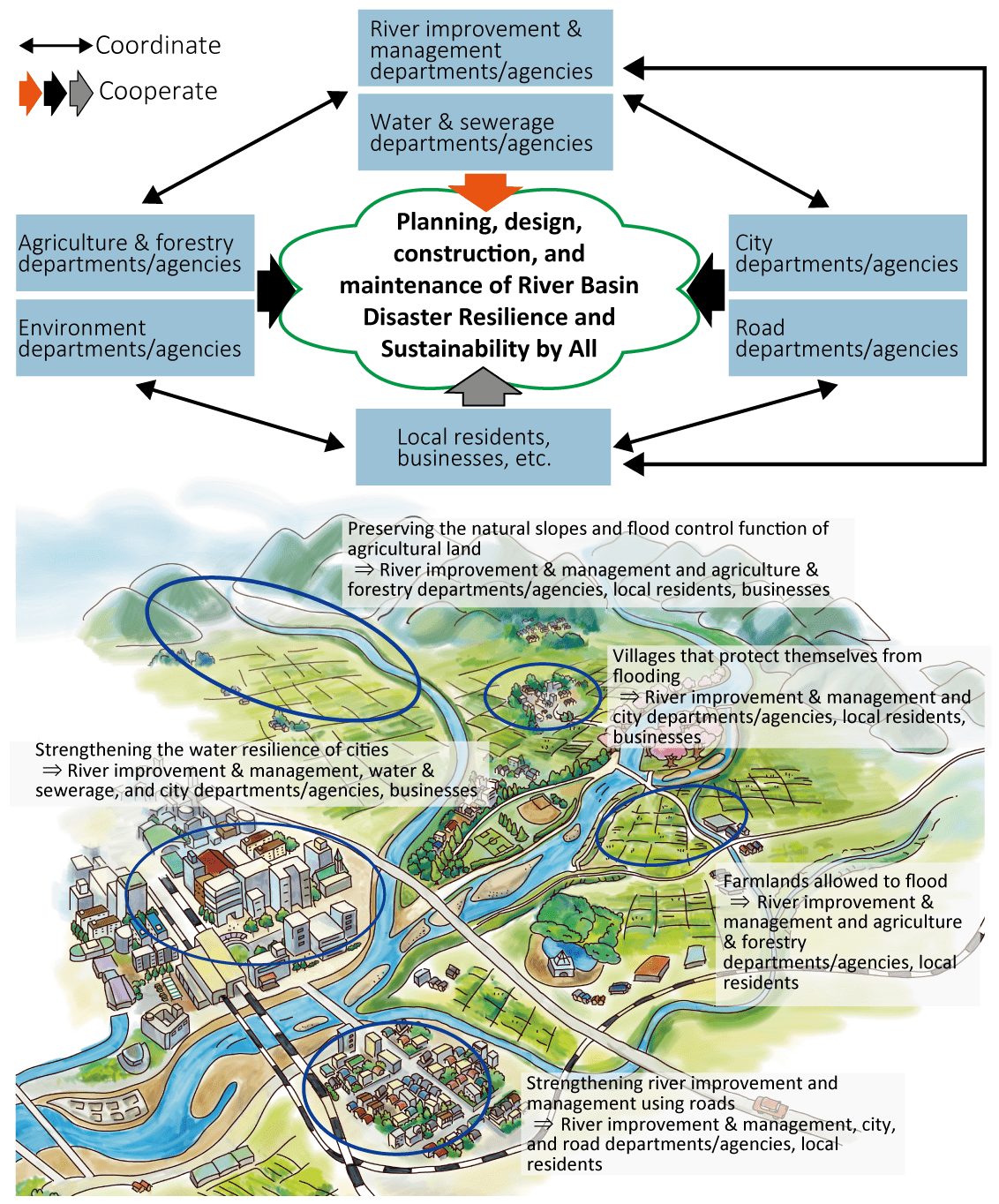2021.03.02
CTIE compiles recommendations for promoting River Basin Disaster Resilience and Sustainability by All, Japan's disaster risk reduction policy that calls for action by all stakeholders in river basins
Technology & Research
On February 22, 2021, CTI Engineering Co., Ltd. (Managing Director and Chief Executive Officer: Tetsumi Nakamura; Headquarters: Chuo-ku, Tokyo) compiled recommendations to promote river basin disaster resilience and sustainability measures with the aim of building a society where people can live safe and secure lives, based on the River Basin Disaster Resilience and Sustainability by All policy reported by the Council for Infrastructure's River Subcommittee in July 2020. The content of the recommendations are summarized below.
1. Background
In recent years, heavy rain disasters, of which climate change is believed to be the main cause, have become a frequent occurrence. Localized torrential downpours are occurring over a wider area and on a scale far more powerful than forecast, causing increasingly severe disasters--including the disasters caused by heavy rain in Kanto and Tohoku in September 2015, heavy rain in northern Kyushu in July 2017, heavy rain in western Japan in July 2018, and Typhoon Hagibis in eastern Japan in 2019. Given the trend of climate change, many believe that the risk of heavy rain disasters will remain unchanged into the future.
During Japan's period of high economic growth, the potential risk of heavy rain disasters rose as residential lots, factories, and commercial facilities spread into areas prone to flooding, partly due to population growth and the proliferation of motor vehicles. Since then, the population has continued to decline after peaking in 2008. At the same time, public investment has fallen due to the declining birthrate, aging population, shrinking working-age population, and growing welfare budget. These factors have hindered preventative maintenance to minimize flooding damage, such as the construction of new flood control facilities and the maintenance and repair of aging facilities. As a result, building national resilience is now an urgent issue.
There is the potential for localized heavy rainfall to occur anywhere, over a wider area and for a longer period of time than ever observed in the past. It is therefore imperative for all regions to think about how they can reduce the damage caused by heavy rainfall.
2. What is River Basin Disaster Resilience and Sustainability by All?
Until now, flood control projects in Japan have mainly been implemented by river administrators. However, in light of the recent heavy rain disasters, it is essential not only to enhance and strengthen flood control projects like never before, but also to tackle flood control measures with the cooperation of all stakeholders in the river basin. For this reason, the Council for Infrastructure's River Subcommittee discussed what measures should be taken to reduce the risk of water-related disasters in light of climate change and issued a report on a new policy called "River Basin Disaster Resilience and Sustainability by All" in July 2020. In addition to the conventional flood control measures implemented mainly by river and sewerage administrators, this new policy redefines the entire river basin (including catchments, river areas, and floodplains) as a single unit for management, and promotes the following measures to minimize flood damage in the river basin through the cooperation of all stakeholders in the river basin.
(1) Flood prevention
(2) Exposure reduction
(3) Disaster resilience
3. Recommendations to promote River Basin Disaster Resilience and Sustainability by All
The CTI Engineering Group has been providing various services related to the development of infrastructure to ensure that the people of Japan and around the world live safe, secure, and comfortable lives. Leveraging the Group's technologies and knowledge as a multi-disciplinary consulting engineering company and based on the report by the Council for Infrastructure, we have compiled these recommendations as a proposal to promote the transition to River Basin Disaster Resilience and Sustainability by All with the aim of building a society where people can live safe and secure lives. The recommendations consist of the following seven items.
Recommendation 1: Promote the cooperation of all stakeholders in the river basin by abolishing the vertical administrative structure (enabling collaboration among all stakeholders)
Recommendation 2: Calculate the impact and benefits of water basin disaster resilience and sustainability measures
Recommendation 3: Operate existing facilities on an emergency basis and improve them further
Recommendation 4: Utilize planned flooding and controlled flood flows (shift to developing for damage dispersion)
Recommendation 5: Promote flood-resistant urban development
Recommendation 6: Ensure the proper communication of information and raise residents' awareness of evacuation
Recommendation 7: Build a system to manage the entire river basin
*The proposal can be viewed here in full (In Japanese only.).

Promote cooperation among all stakeholders in the river basin